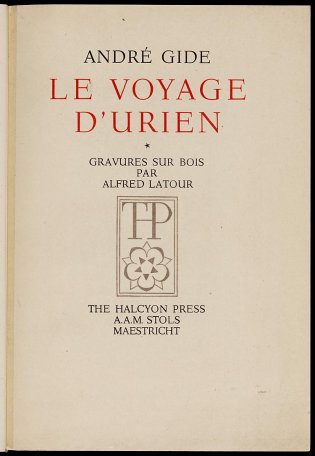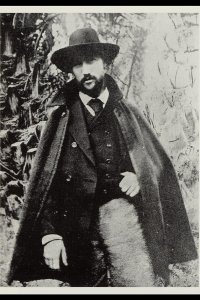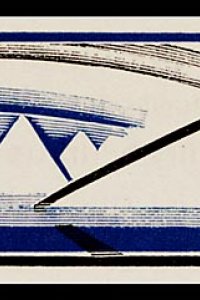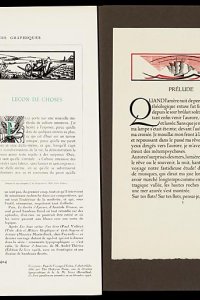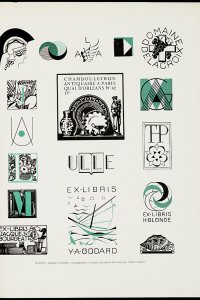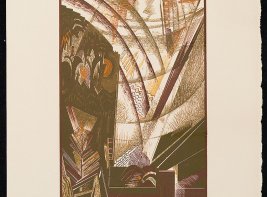Le voyage d'Urien
Year: 1928
Author: André Gide (1869 - 1951)
Artist: Alfred Latour (1888 - 1964)
Publisher: The Halcyon Press
In Le voyage d'Urien, the main character Urien's voyage is described, but it is also a pun on Le voyage du rien: 'the meaningless voyage' or 'the voyage to nowhere'. The ending reads: we haven't made that voyage, it was only a dream, we were reading a book. The voyage of Urien and his twenty friends carries them among enchanted islands where beautiful women seduce a number of them, who subsequently die of a contagious disease. Twelve of them survive, sailing across a sea that is covered in seaweed, where Urien meets his sister Ellis. She is reading Kant and Leibnitz, but he throws her books away because they are seductresses in disguise. Ellis pales and vapourizes. Seven friends remain for the third and final chapter, which takes place on a sea of ice. After the physical infections of the 'Océan pathétique' and the spiritual death of the 'Mer des Sargasses', they subsequently find themselves in the land of Eskimo zombies, where scurvy rules. An elixir of life heals them of this and the real Ellis predicts that all voyages lead to God, but the ending is a disappointment to them. They chip away the ice from the grave of a man who holds a note in his hand. This proves to be a blank piece of paper.
Art of abbreviation
Alfred Latour, painter in watercolours, landscape artist, engraver and illustrator, learned his trade from Auguste Lepère and Carlègle (C.E. Egli). He was the co-founder of the Association du livre d'art français, and exhibited his work regularly in broad circles. He originally painted Impressionist tableaux. From 1940 onwards, he focused mainly on typography and decorations (woodcuts), bookbindings, posters and advertisements. Innumerable illustrated works (from 1922), bookplates, and printed fabrics for the haute couture were the result. He ultimately opted for abstract painting. The Koopman Collection includes books with simple woodcut decorations for Émile Chamontin's publisher Le Livre, for instance Jacques de Lacretelle's Dix jours en Ermenonville (1926). Some of those vignettes play with typographical and calligraphic elements. The woodcuts created for Blaise Cendrars' Comment les blancs sont d'anciens noirs, published by Au Sans pareil in 1930, were much more sophisticated. These illustrations were printed in two colours. Latour's decorations for Le voyage d'Urien were initially unable to please the author, who was so fond of 'typographie pure', until his friends managed to convert him. They admired the tight design and the use of colour. The woodcuts were printed in two stages: first in black, and subsequently in red or blue. The borders were also divided into two parts, one corner of which was printed in black, and the other in colour. The vignettes feature a highly sophisticated design, and their presentation is abstract with suggestive figures, like ships, clouds, waves, and mountains. By way of advertising for this edition, two proof sheets were added as glued-in appendices in the magazine Arts et métiers graphiques. The accompanying article praises his calm working method, his 'art of abbreviation' and his use of colour. Latour also designed the publisher's emblem for Halcyon Press for this edition. The colourful edition of Le voyage d'Urien was held out to other- more frugal- publishers as a shining example.
Bibliographical description
Description: Le voyage d'Urien / par André Gide ; [orné de grav. sur bois par et de lettrines Alfred Latour dess. par Alphonse Stols]. - Maestricht : Halcyon Press, 1928. - [94] p. : ill. ; 25 cm
1st edition: 1893
Printer: Boosten & Stols (Maastricht)
Edition: 330 copies
This copy: Number 191 of 300 on Hollands Pannekoek
Typeface: Lutetia
Bookbinder: Schrijen (Sittard)
Bibliography: Bénézit 8-312 ; Carteret V-90 ; In liefde verzameld 125 ; Mahé II-217 ; Monod 5371
Shelfmark: KW Koopm B 769
References
- Alfred Latour: les gestes d'un homme libre. Arles, Actes Sud, 2018
- Paul van Capelleveen, Sophie Ham, Jordy Joubij, Voices and visions. The Koopman Collection and the Art of the French Book. The Hague, Koninklijke Bibliotheek, National Library of the Netherlands; Zwolle, Waanders, 2009
- Paul van Capelleveen, Sophie Ham, Jordy Joubij, Voix et visions. La Collection Koopman et l'Art du Livre français. La Haye, Koninklijke Bibliotheek, Bibliothèque nationale des Pays-Bas; Zwolle, Waanders, 2009
- Louis Cheronnet, 'Les tissus imprimés d'Alfred Latour', in: Arts et métiers graphiques, (1932) 27, p. 32-34
- C. van Dijk, Alexandre A.M. Stols 1900-1973: Uitgever, typograaf: Een documentatie. Zutphen, Walburg pers, 1992
- C. van Dijk, Alexandre A.M. Stols en André Gide. Oosterhesselen, De Klencke Pers, 1991
- Pascal Forthuny, 'Le graveur Alfred Latour', in: Arts et métiers graphiques. (1928) 7, p. 421-428
- Paul Istel, 'Reliures d'Alfred Latour', in: Arts et métiers graphiques, (1930) 20, p. [97]
- Pierre Lepape, André Gide, le messager: Biographie. Paris, Seuil, 1997
- 'L'oeil du bibliophile', in: Arts et métiers graphiques, (1929) 9, p. 572-577. [Recensie op p. 575]
- Alan Sheridan, André Gide: A life in the present. Cambridge, MA, Harvard University Press, 1999
- Nanske Wilholt, Voor alles artiste. Uitgever Stols en het literaire leven in het Interbellum. Zutphen, Walburg Pers, 2001
